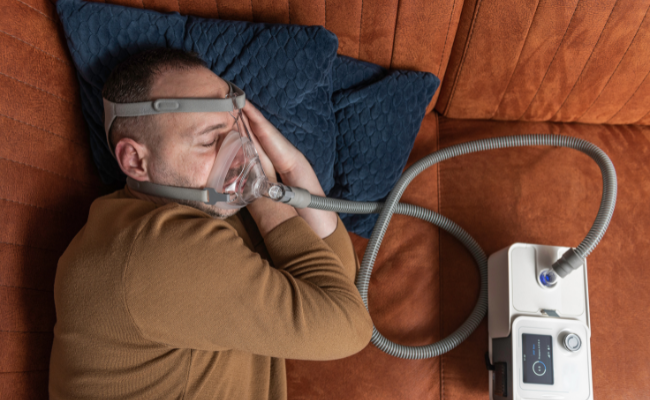How to Treat Obstructive Sleep Apnoea?
- October 20, 2023
- No Comments

What is Obstructive Sleep Apnea (OSA)?
Obstructive Sleep Apnea (OSA), a widespread sleep disorder, disrupts normal breathing by causing the muscles at the back of the throat to excessively relax, resulting in a partial or complete blockage of the upper airway. These interruptions, known as apneas, last for varying durations and recur throughout the night, disturbing the natural sleep cycle and lowering oxygen levels in the bloodstream.
This condition arises from an airway obstruction that hinders the smooth flow of air through the windpipe during sleep. The ensuing reduction in airflow leads to a decrease in blood oxygen levels, prompting a survival reflex in the brain to initiate brief awakenings and restore regular breathing patterns.
Why Does Obstructive Sleep Apnea Occur?
The primary cause of OSA lies in the relaxation of throat muscles during sleep, leading to the narrowing or closure of the airway. Several factors contribute to this phenomenon. Excess weight and obesity are significant risk factors, as the accumulation of fatty tissue in the neck region can constrict the air passage. Anatomical factors, such as a naturally narrow airway, enlarged tonsils, or a recessed jaw, may also contribute to OSA.
Lifestyle choices play a role; smoking and excessive alcohol consumption can relax muscles, including those in the throat. Age is another factor, as the risk of OSA increases with age. Additionally, genetics and family history may predispose individuals to this sleep disorder. Certain medical conditions, such as hypertension and diabetes, are linked to an elevated risk of developing OSA.
How to Identify Obstructive Sleep Apnea?
Recognizing the signs and symptoms of OSA is crucial for timely intervention. Common indicators include loud and persistent snoring, sudden awakenings accompanied by a choking or gasping sound, daytime sleepiness and fatigue, difficulty concentrating, irritability, and morning headaches. Partners or family members may observe these symptoms, especially the disruptions in breathing during sleep.
Formal diagnosis typically involves a sleep study, known as polysomnography, conducted in a sleep center. This study monitors various parameters during sleep, including brain activity, eye movement, heart rate, respiratory effort, air flow, and blood oxygen levels. The results help determine the severity of OSA and guide the selection of an appropriate treatment plan.
Treatment Solutions for Obstructive Sleep Apnea
Lifestyle Modifications:
- Weight Loss: For individuals with obesity, shedding excess weight can significantly alleviate OSA by reducing the pressure on the airway.
- Positional Therapy: Sleeping on the side rather than the back can prevent the tongue and soft palate from collapsing into the airway.
- Continuous Positive Airway Pressure (CPAP): The CPAP machine is a widely used and effective treatment for OSA. It involves wearing a mask that delivers a continuous stream of air, preventing airway collapse during sleep. Consistent use of CPAP is crucial for its effectiveness.
Oral Appliances:
- Mandibular Advancement Devices (MADs): These devices, resembling mouthguards, reposition the jaw and tongue to keep the airway open. They are particularly useful for those with mild to moderate OSA.
Surgery:
- Uvulopalatopharyngoplasty (UPPP): This surgical procedure removes excess tissue from the throat, widening the airway.
- Genioglossus Advancement (GA): Another surgical option repositions the tongue muscles to prevent airway collapse.
Inspire Therapy:
- Implantable Device: Inspire therapy involves surgically implanting a device that stimulates the hypoglossal nerve, preventing airway collapse during sleep. It is an innovative option for those who cannot tolerate or benefit from CPAP.
Benefit Points of Treating Obstructive Sleep Apnea
- Improved Sleep Quality: Addressing OSA leads to improved sleep quality, with fewer interruptions and better maintenance of the natural sleep cycle.
- Enhanced Daytime Alertness: Effective treatment results in increased daytime alertness, improved concentration, and enhanced cognitive function, reducing the risk of accidents and boosting overall productivity.
- Lowered Health Risks: Managing OSA contributes to a decreased risk of associated health issues, including hypertension, cardiovascular diseases, and diabetes.
- Alleviation of Symptoms: Treatment reduces or eliminates symptoms such as loud snoring, choking, and gasping during sleep, improving the sleep experience for both the affected individual and their sleep partner.
- Prevention of Complications: Properly treating OSA helps prevent complications such as cardiovascular diseases, strokes, and the exacerbation of existing health conditions associated with untreated sleep apnea.
Comments (0)